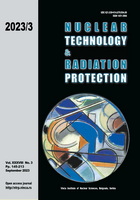
ASSESSMENT OF OCCUPATIONAL EYE LENS EXPOSURE DURING IMAGE-GUIDED ORTHOPEDIC PROCEDURES

Vol.
XXXVIII, No. 3, Pp. 145-213
September 2023
UDC 621.039+614.876:504.06
ISSN 1451-3994
Pages: 202-207
Authors: Jelena J. Samac, Predrag M. Božović, Jelena S. Stanković Petrović, Borislava Petrović, Miodrag N. Vranješ, Predrag V. Rašović, and Mirko M. ObradovićAbstract
This study aimed to investigate the level of exposure of eye lenses in orthopedic surgeons per- forming routine clinical work and to determine future monitoring practice, as Serbian radiation protection law still employs higher limits. The dose was measured monthly in terms of Hp(0.03) with three different dosimeters placed on a 3-D-printed headband, worn on a forehead by three orthopedic surgeons, during all procedures involving fluoroscopy. The mean dose for the left and right eye was 271 ±109 µSv and 269 ±101 µSv, respectively, with no significant difference
(p-value 0.977) between the left and right eye observed. Considering the highest recorded monthly value, the annual dose is expected to be 4.85mSv without protective items, well below the new ICRP limit of 20 mSv. There was no observed correlation between eye lens dose and both fluoroscopy time and exposure parameters. Considering the cumulative impact of dose and the evidence pointing to an elevated incidence of lenticular opacities for cumulative doses exceeding 10 mSv, it is advisable to institute ongoing monitoring, especially when new surgeons incorporate image-guided procedures or when novel techniques are introduced into surgical practice.
Key words: eye lens dose, orthopedic surgery, fluoroscopy, radiation protection, individual monitoring
FULL PAPER IN PDF FORMAT (651 KB)